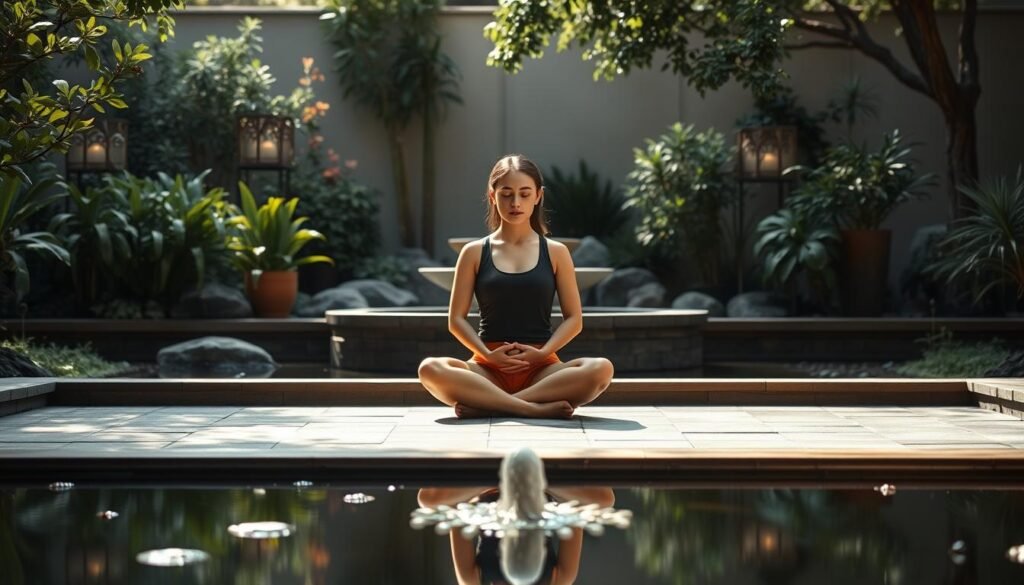Can we find a calm mind in today’s fast world? With endless info and demands, it’s easy to feel lost and unclear.
Practicing mindfulness meditation can help a lot. Just a few minutes each day can bring calm and focus.
This article will show how mindfulness and meditation can improve our lives. It’s a step towards mental clarity and peace.
Key Takeaways
- Discover the importance of mindfulness meditation for mental clarity
- Learn how to achieve a calm mind through mindfulness practices
- Understand the benefits of incorporating meditation into daily life
- Explore the connection between mindfulness and mental peace
- Find practical tips for starting a mindfulness meditation practice
Understanding Mindfulness Meditation
Mindfulness meditation has a big impact on our mental and emotional health. It comes from ancient traditions and is now widely used for mental clarity and peace.
This practice helps us stay present and aware in our daily lives. It reduces stress and anxiety, making life more balanced.
Definition and Origins
Mindfulness meditation means paying attention to the now without judgment. It started in ancient Buddhist traditions to find enlightenment and peace.
It involves focusing on breathing, body feelings, or emotions. This helps us understand ourselves better and manage stress.
Key Benefits of Mindfulness Meditation
Mindfulness meditation offers many benefits, like less stress and anxiety. It also improves emotional control. Regular practice boosts mental clarity and well-being.
- Reduces stress and anxiety
- Improves emotional regulation
- Enhances mental clarity and focus
- Promotes better sleep quality
Adding mindfulness meditation to our daily lives can bring these benefits. It’s a simple yet effective way to improve our mental health.
As a form of stress relief meditation, mindfulness helps us deal with today’s challenges. Regular practice leads to a more resilient and peaceful mind.
The Science Behind Stress Relief Meditation
Research has shown that meditation can help reduce stress. It’s a key part of mindful living. Studies have found that it can help both the body and mind feel better.
Meditation changes the brain in many ways. It helps with emotions, memory, and how we handle stress. Regular practice can even change the brain’s structure and function.
How Meditation Affects the Brain
Meditation has several effects on the brain. It helps manage stress through relaxation techniques. One key way is by lowering cortisol, the stress hormone.
It also affects the brain’s default mode network (DMN). This network is for self-thoughts and mind-wandering. Meditation reduces DMN activity, leading to less rumination and more mental clarity.
Research Studies Supporting Stress Relief
Many studies have looked into meditation’s effects on stress. They show strong evidence of its benefits. A review of these studies found that meditation can greatly reduce stress and anxiety.
| Study | Sample Size | Key Findings |
|---|---|---|
| Journal of the American Medical Association (JAMA) Study | 300 participants | Meditation reduced symptoms of anxiety and depression by 40% |
| National Center for Complementary and Integrative Health Study | 200 participants | Mindfulness meditation decreased cortisol levels by an average of 20% |
| University of California, Los Angeles (UCLA) Study | 150 participants | Regular meditation practice increased grey matter in areas associated with attention and emotional regulation |
These studies highlight meditation’s value for mental health. They show it can be a powerful tool for improving well-being. It supports the use of relaxation techniques and mindful living in everyday life.
Practicing Mindfulness for a Calm Mind
Mindfulness is a simple yet powerful way to lower stress and boost mental health. Adding mindfulness to your daily life helps manage stress and brings calm.
Daily Mindfulness Exercises
Doing mindfulness exercises every day can clear your mind. Simple activities like deep breathing, body scan meditation, and mindful walking fit easily into your day.
- Deep Breathing: Focus on slow, deliberate breaths to calm the mind.
- Body Scan Meditation: Lie down or sit comfortably, bringing awareness to different parts of the body.
- Mindful Walking: Pay attention to the sensation of each step while walking.
Integrating Mindfulness Into Daily Life
Mindfulness isn’t just for meditation. It can be part of everyday activities like eating, driving, and talking.
Eating mindfully means enjoying each bite. Notice the flavors, textures, and smells. It makes meals more enjoyable and can help with digestion.
Avoiding Common Mindfulness Pitfalls
While mindfulness is great, there are traps to watch out for. These include expecting too much, practicing with distractions, and comparing yourself to others.
| Common Pitfall | Avoidance Strategy |
|---|---|
| Setting Unrealistic Expectations | Start with short, achievable mindfulness sessions and gradually increase duration. |
| Practicing with Distraction | Find a quiet, comfortable space for mindfulness practice, free from distractions. |
| Comparing Oneself to Others | Focus on personal progress and experiences, avoiding comparison. |
Knowing these pitfalls and how to avoid them makes mindfulness more effective and rewarding.
Different Types of Meditation
Meditation offers many ways to find inner peace. You can try mindfulness meditation or other types like transcendental, loving-kindness, and movement meditation.
Mindfulness vs. Other Meditation Techniques
Mindfulness meditation helps you stay in the present moment. It lets you watch your thoughts and feelings without judging. On the other hand, transcendental meditation uses a mantra to calm the mind. Loving-kindness meditation focuses on spreading love and kindness to yourself and others.

It’s important to pick a meditation that fits your goals and likes.
Choosing the Right Style for You
Think about what you want from meditation. If you want to find inner peace and reduce stress, mindfulness might be good. For more love and kindness, try loving-kindness meditation.
- Try different meditations to see what works for you.
- Think about your life and how much time you can meditate.
- Start with guided meditations online or through apps.
Creating a Meditation Space
To get the most out of meditation, you need a good environment. A well-made meditation space can really help you relax and focus. It’s key to making your meditation better.
Importance of Environment
The place where you meditate is very important. A messy or noisy area can pull you away from your focus. But a calm, quiet spot can help you relax more deeply.
It’s all about making a space that’s just right for you. It should be free from distractions and match what you like.
Tips for Setting Up Your Meditation Area
Creating a meditation spot needs some thought. First, pick a quiet spot away from daily noise. Make sure it’s clean, tidy, and has good air.
Think about the lighting too. Soft, natural light is best. But if that’s hard, candles or dim lamps can make it cozy.
- Choose a comfy seat, like a cushion or chair, that keeps your back straight.
- Turn off gadgets or use a white noise machine to block out sounds.
- Add things that calm you, like plants, soft colors, or inspiring words.
Designing your meditation area well can make a big difference. It helps you relax more and feel calm.
Guided Meditations for Beginners
Guided meditations are a great way for beginners to start. They are led by an instructor who guides you through steps to reach a meditative state. This is especially helpful for those who find it hard to focus or relax on their own.
Guided meditations come in many formats, like audio recordings, videos, and apps. They often use soothing music, nature sounds, or gentle voices to help you relax and focus. According to
“Guided imagery and meditation can be used to promote relaxation, reduce stress, and improve overall well-being.”

Where to Find Quality Resources
There are many online platforms and resources for beginners. Websites like YouTube, meditation apps, and wellness sites offer a wide range of guided meditations. They cater to different needs and preferences.
Online communities and forums are also great places to find guided meditations. Members share their favorite meditations. These communities help you discover new content and connect with others who enjoy meditation practices.
Popular Apps for Stress Relief
Many mobile apps are known for their guided meditation content. They have user-friendly interfaces. Some of the most popular apps include:
- Headspace
- Calm
- Insight Timer
These apps offer various guided meditations, sorted by theme, duration, or difficulty level. They also track your progress and offer personalized plans. This makes it easier for beginners to stick to a relaxation technique practice.
By checking out these resources, beginners can find the guided meditations that fit their needs. This helps them develop a deeper sense of calm and well-being.
Incorporating Breathing Techniques
Mindful breathing is a powerful tool for meditation. It helps you feel more mentally clear and less stressed. By focusing on your breath, you stay in the present moment. This leads to deeper relaxation and better concentration.
Breathing techniques are key in meditation. They help calm your mind and improve focus. Regular use can also improve emotional control and overall well-being.
Breath Awareness for Enhanced Focus
Breath awareness means paying attention to your breath. It helps you stay present and focused. This reduces mind-wandering and boosts concentration.
To practice, sit comfortably, close your eyes, and focus on your breath. Feel the breath moving in and out. Gently acknowledge any thoughts without getting caught up in them.
Simple Breathing Exercises
There are simple breathing exercises for meditation. The 4-7-8 Breathing Technique, or “Relaxation Breath,” is one example.
- Inhale through your nose for a count of 4.
- Hold your breath for a count of 7.
- Exhale through your mouth for a count of 8.
This technique can slow your heart rate and relax you. Another good one is Box Breathing. Breathe in for 4 counts, hold for 4, breathe out for 4, and hold again for 4. This creates a “box” pattern with your breath.
Adding these breathing techniques to your meditation can improve focus and reduce stress. It also helps you feel calmer and more well-rounded.
Overcoming Challenges in Meditation
Meditation is a journey to mental clarity and inner peace, but it’s not easy. It comes with its own set of challenges. Despite these, regular practice can greatly improve your mental health. Knowing how to handle common obstacles is key.
Dealing with Distractions
Distractions are a big challenge in meditation. They can be anything from outside noise to thoughts in your head. The trick is to learn to acknowledge and let go of these distractions gently.
Try focusing on your breath. Just watch its pattern without trying to control it. If your mind drifts off, simply note the thought and bring your focus back to your breath.
Guided meditations can also help. They offer a soothing story to follow, keeping your focus.
Managing Expectations
Many start meditation with high hopes, like a blank mind or a certain feeling. But meditation is personal, and everyone’s experience is different.
It’s important to manage these expectations. Meditation isn’t about reaching a certain state. It’s about being aware and accepting of the moment.
By dropping these expectations, you can make meditation more positive and effective. This leads to more inner peace and mental wellness.
Mindfulness in Everyday Activities
Everyday tasks can become chances to practice mindfulness, making life more peaceful. By adding mindfulness to daily routines, we can turn simple tasks into moments of clarity and calm.
Eating Mindfully
Eating is a big part of our lives, and eating mindfully can greatly improve our health. Mindful eating means focusing fully on the act of eating and drinking, enjoying each bite, and noticing the flavors and textures.
To eat mindfully, start by eating slowly and without distractions like TV or phones. Pay attention to the colors, smells, and tastes of your food. Chew well and pause between bites to fully enjoy the sensations.
Mindful Walking
Mindful walking brings mindfulness into our daily lives. It’s about noticing the feel of each step, the movement of our body, and what’s around us. This practice can make a simple walk a meditative experience, improving our mental clarity and reducing stress.
To practice mindful walking, find a quiet spot to walk. Focus on the feel of your feet on the ground, the rhythm of your breath, and your surroundings. Notice the sights, sounds, and smells around you, staying fully present in the moment.
By adding mindfulness to daily activities like eating and walking, we can become more aware and peaceful. Regular practice can also improve our mental health and make daily life more mindful.
Building a Consistent Practice
A regular meditation practice is key to enjoying its benefits. It helps you live a more peaceful and focused life. To make meditation a part of your daily routine, you need to understand how to do it well.
Setting Realistic Goals
Starting with realistic goals is crucial for a consistent meditation practice. Begin with achievable targets, like meditating for a few minutes a day. Then, you can increase the time as you get more comfortable with it.
- Start small to avoid frustration and maintain motivation.
- Be consistent in your practice, even if it’s just for a short period each day.
- Adjust your goals as needed based on your progress and comfort level.
Tracking Your Progress
Tracking your progress can be a great motivator. Consider keeping a meditation journal to record your daily practice. Note any observations or insights you gain.
“The journey of a thousand miles begins with a single step.” – Lao Tzu
This quote shows the importance of building a consistent meditation practice. It’s about taking it one step at a time and staying committed to your journey.
The Long-term Benefits of Regular Meditation
Regular meditation can greatly improve your life. It makes you feel better and live better. Adding meditation to your daily routine can bring big changes.
Enhanced Cognitive Function
Meditation boosts your mental sharpness and focus. You can do things more quickly and better. This is because meditation trains your mind to stay focused and aware.
Emotional Resilience
Meditation also helps you handle your emotions better. It makes you more aware of your feelings. This way, you can deal with stress and life’s ups and downs more easily.
Starting a meditation habit can make your life more balanced and fulfilling. It shows how important it is to make mindfulness a part of your daily life.



